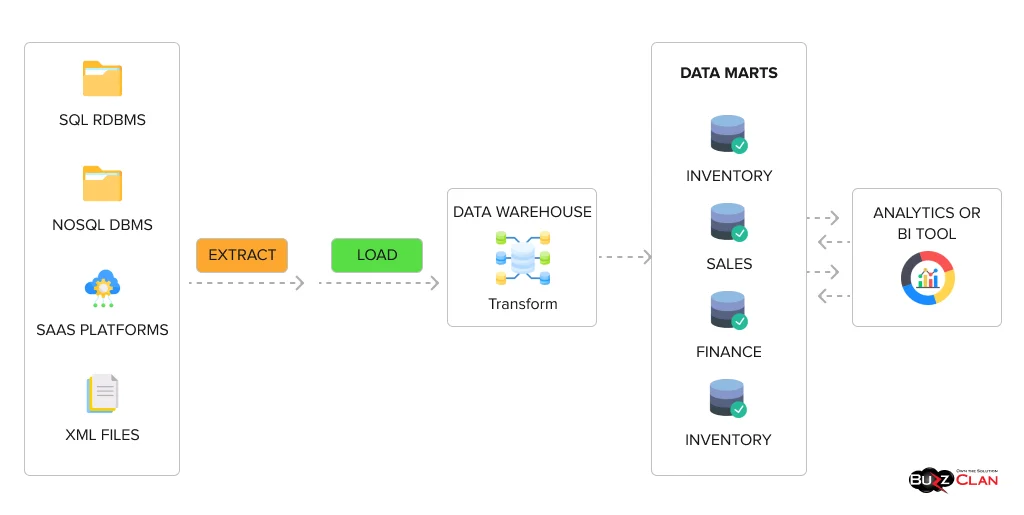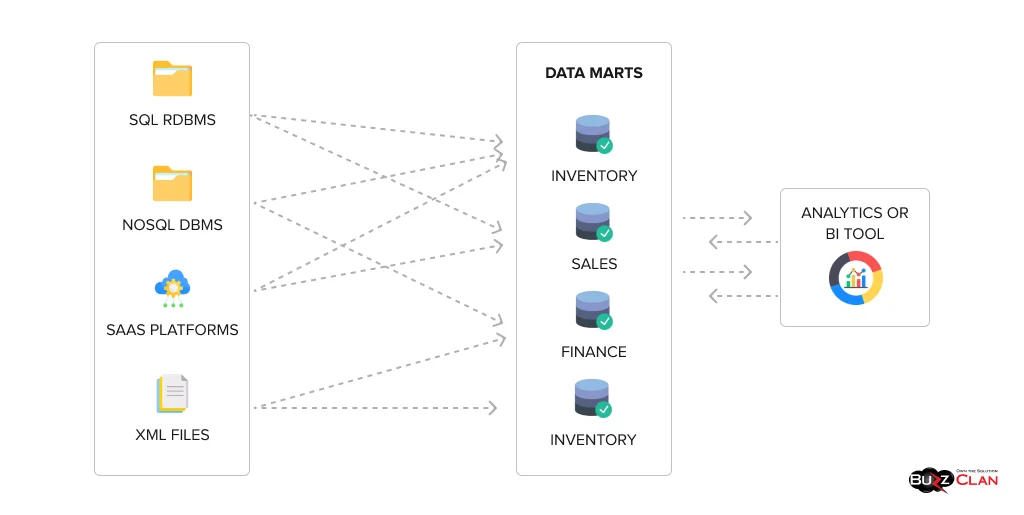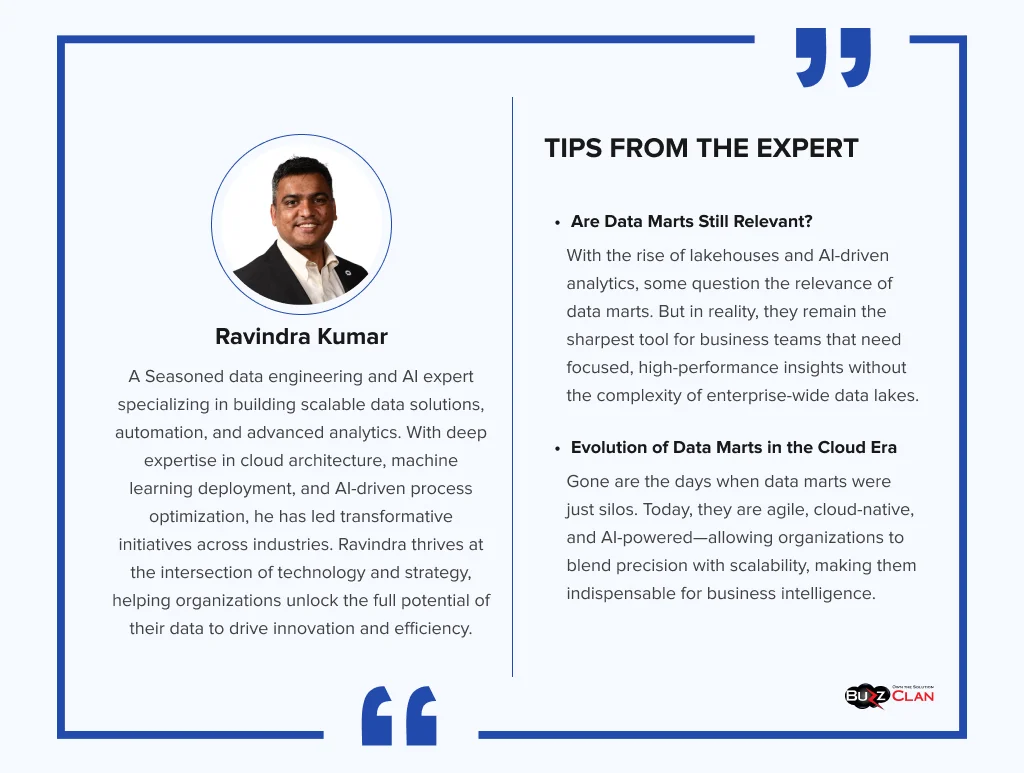Data Marts: The Complete Guide to Streamlined Business Intelligence
Deepak Desai
Apr 11, 2025
The total amount of data created, captured, copied, and consumed globally is forecast to increase rapidly, reaching 149 zettabytes in 2024 and is projected to grow to more than 394 zettabytes by 2028. With so much data, organizing it becomes a challenge. Several methodologies, such as data lakes and warehouses, are crafted to manage data. However, for more specific work and departments, data marts are created.
Imagine there are data repositories for a particular subject area, business function, or group of users that help users and operations to operate more efficiently and effectively. Wouldn’t it be fantastic? A subset of the database allows businesses to do the same, known as a Data Mart. Learn what a data mart is, exploring the subject matter in its entirety.
What is a Data Mart?
A data mart is a data store designed for a particular department of an organization. It is a subset of the data warehouse usually oriented to a specific purpose. A data mart is used to analyze and make decisions about a particular business area. More specifically, let’s see what the father of data warehousing “Bill Inmon” says about data mart:
“A data mart is a structure or access pattern specific to data warehouse environments, designed to meet the needs of a particular line of business.”
An organization may have a large amount of data related to finance, sales, payroll, recruitment, and other areas. Data lakes and warehouses sort and store unstructured, semi-structured, or structured data. However, suppose a single department needs a particular data type, such as the HR department, which wants recruitment data. In that case, data marts are used for these specific and personalized data needs and requirements.
Businesses should consider data marts for business intelligence. They provide a focused, smaller subset of data relevant to specific departments or business functions, enabling faster access to critical insights.
Types of Data Mart
There are three types of data marts. These types go from sourced data to organized data from the data warehouse to a mix of both. Let’s understand them in detail:
Dependent Data Mart

As the name suggests, a dependent data mart depends on the data warehouse. First, the data warehouse collects the data from the source and then crafts a subject-specific data mart according to the department’s needs and requirements using ELT (extract, load, and transform) processes. It’s also known as the top-down approach.
Pros & Cons:
- There is no need for highly skilled database management business analysts.
- It makes retrieving information much swifter.
- If a data warehouse fails, all the data marts lead to failure.
Independent Data Mart

An independent data mart does not come from a central data warehouse. It extracts its data from direct data sources. Independent data marts suit smaller companies, but only specific departments can access and analyze information. Data sources such as SQL RDBMS, NOSQL DBMS, SAAS platforms, and XML files are utilized and filtered to create personalized data marts for departments such as sales and inventory. Another name for an independent data mart is the bottom-up approach.
Pros & Cons:
- Easy to set up.
- Departments can share the data mart and augment it with their data.
- Managing an independent data mart is difficult because of business analysts’ extensive database administrative work.
Hybrid Data Mart

What is a hybrid? It’s a mix of the two. Similarly, a hybrid data mart takes the data from both a data warehouse and independent data sources. How does it help businesses? Companies can use the flexibility to test independent data sources before they can use that data to create data warehouses.
Pros & Cons:
- Improved data accessibility
- Tailored analysis
- Potential data integration challenges
Benefits of Implementing a Data Mart
Data mart has several benefits, including improving efficiency, offering qualitative data, reducing costs, and providing faster access to relevant data. Let’s understand them one by one:
- Low costs (software and hardware): It doesn’t matter which type of data mart requires less infrastructure and maintenance costs; they all have low fees. Creating these data marts is generally low, as they don’t need a big central data storage facility. With their low infrastructure and maintenance costs, maintaining them is also cost-effective.
- Simpler, More Focused, and Flexible: Which will be simpler? Building a water body for a whole village or just for a house? Similarly, building and maintaining a data mart is simpler to craft, serving the needs of specific business teams requiring access to fewer data sets.
- It is faster and cheaper to build: Due to its department-level decision-making nature, a data mart is quick to make compared to a data warehouse with an enterprise-wide approach. Moreover, it is also cheap compared to other data storage solutions, as it only stores and manages data from a specific business area. This requires less storage space, processing power, and overall infrastructure, which further helps lower development and maintenance costs.
- Stores data closer, enhancing performance: Often, live data is collected from a data warehouse linked to other data sources. Once this connection is settled, the live data can be used in various functions, such as customer service interactions, stock market trading, manufacturing production lines, and supply chain management. Because of this near data, particular business teams don’t have to go to IT to obtain periodic extracts for their operations.
How Data Marts Work
Data mart works is a subject-oriented database built from a larger data warehouse. Here’s how a data mart works:
ETL Processes
ETL means extracting, transforming, and loading the data into data marts. It involves extracting, transforming, and loading the data acquired from multiple sources or warehouses. To understand these individually, let’s dive deeper into them:
- Extracting: Data is extracted from data sources such as databases, APIs, and flat files using tools such as Informatica and Talend.
- Transforming: In this stage, the extracted data is cleansed, enhanced, and restructured to meet the target schema requirements. This includes filtering, sorting, aggregating, joining, data cleansing, deduplicating, and validating data.
- Loading: Loading, as usual, means the data is loaded into the right data warehouse and data mart. Two methods are used: full load (initial load of all data) and incremental load (loading only new or changed data).
Data Access and Analysis
Business users can quickly access specific data categories to evaluate and produce reports. Data marts often provide tools for querying and visualizing data, enabling users to derive insights more quickly.
This is how data marts work, managed by the enterprise data team. Business group data stewards maintain the data mart, and end users have read-only access to prevent accidental data modification.
The Role of Data Marts in Business Intelligence (BI)
The role of data marts in business intelligence surpasses that of data warehouses and lakes. Let’s examine their role in how they transform, strengthen, and improve the business intelligence operations and services for a business:
Faster Analysis
Data marts include datasets regarding a particular business operation or department, such as finance or marketing. This small database enhances performance because access is more organized and clear. Now, data analysis is not done between piles of unorganized data. It is more cataloged. Moreover, it opens the gates for more exploration and analysis of the data.
More Agility
Since the data insights are ready in the data marts, companies can fulfill their needs more quickly. Different departments can access valuable data for their operations from assigned data marts. Previously, organizations had to navigate the complexities of a complete data warehouse.
Augmented Decision-Making
With data on fingerprints that are used for instantaneous access to departmental operations, businesses can improve their decision-making, historical data analysis, and data mining. Rapid and effective decision-making based on accurate data leads to enhanced solutions for customers and business clients.
Self-Service Analytics
Users can store and explore data through fully managed databases using self-service analytics solutions like data marts. The system bridges business personnel and IT staff, handling data ingestion, transformation, and loading through its no-code and low-code capabilities.
Integration with BI Infrastructure
Data marts truly shine when they are integrated with BI infrastructure. What do they do? Their sole purpose is to provide a focused, readily accessible data source for specific business needs, and this accessibility is paramount when linking them to visualization tools, dashboards, and other BI components. Let’s understand in depth how the integration works when linking the BI components:
- Visualization Tools: Data marts provide optimized data for tools like Tableau/Power BI, enabling fast, interactive reports and dashboards.
- Dashboards: They fuel dashboards with pre-aggregated KPIs, allowing drill-downs and scheduled updates.
- EDW Connection: Data marts are subject-specific subsets of a central data warehouse, ensuring data consistency.
Cost-Effective
They are more cost-effective and less expensive to set up than data warehouses.
Steps for Planning and Structuring a Data Mart
Structuring a data mart is done with deep planning. An effective data mart isn’t effective if its architecture/structure is not made correctly. Don’t mistakenly make this mistake. Let’s understand what the steps are for planning and structuring a data mart:
Identification of Business Goals & Objectives
Why do businesses want a data mart? Answer the earlier question to maximize results and avoid effort duplication. The sole purpose of this question is to know your business goals and objectives. Identifying business goals and what the business wants to achieve will clarify the sides. The technical team can shape the data structure and ETL processes to attain maximum results, all due to identifying business goals and objectives. Building a data mart that aligns with the business’s goals is a prerequisite for future success.
Defining the Scope & Requirements
Businesses should define the scope and requirements to achieve high customer satisfaction, leading to high revenue and increased trust. The scope here means the project scope or the requirements that will be needed for a specific project. For example, if a company, “ABC,” innovates in sales and marketing, the company’s parameters should include geographic locations, product categories, and customer demographics for a helpful data mart. Define the data model and schema, including fact and dimension tables. Choose an appropriate schema design based on analytical needs. There are three main types of data schemas, these are as follows:
- Star Schema: This is the simplest and most widely used schema. It consists of a central fact table surrounded by denormalized dimension tables. The star schema is efficient for querying because fewer joins are required.
- Snowflake Schema: A snowflake schema is an extension of the star schema where the dimension tables are further normalized into sub-dimension tables.
- Vault Schema: It is a modern approach that provides agility and flexibility by eliminating the need for data cleansing and streamlining the addition of new data sources.
Design the Data Model
Data models are diagrammatic or visual representations of how data is structured and related. They are blueprints for how an organization collects, stores, and analyzes data. There are three types of data models: conceptual, logical, and physical. Effective data modeling helps companies distribute and organize data efficiently. Designing a data model is necessary because it can improve efficiency. Business owners should consider the relationships between data elements, data granularity, and historical duration when designing effective data models in a data mart.
Extract, Transform, and Load (ETL) Data
ETL processes ensure data is accurate, consistent, and ready for analysis. ETL means extracting, transforming, and loading the data into data marts. The data is extracted from multiple sources, and the helpful data for the project consumption is chosen. After that, the data is transformed into a standard/consistent format to be later loaded into the data marts for business operations.
Prioritize Security & Compliance Measures
A multi-layer approach is always better than a single-layer approach. This is also true of business cybersecurity. An organization should prioritize security measures by restricting unauthorized access. This can be done effectively with multifactor authentication (MFA), row-level strategy, and role-based access control. Compliance is necessary for regulatory adherence and data recovery of data marts. Prioritizing security and compliance measures should be done effectively throughout the structuring of the data mart. Unable to do this will lead to cyberattacks, such as malware, ransomware, and SQL injection.
Monitor > Optimize
This last stage involves monitoring and optimizing the data mart’s ongoing issues, performance, and data quality, as well as optimizing it for better performance, including updates. This is done extensively through user feedback, iterative improvement, data validation, etc., helping the company’s department stay ahead of the competition with advanced technology and specified data.
Data Marts vs. Data Warehouses vs. Data Lakes
Data lake vs data warehouse vs data mart. These appear to be similar, but they aren’t. Let’s understand how these are different from each other in a comprehensive way:
| Feature | Data Mart | Data Warehouse | Data Lake |
|---|---|---|---|
| Purpose | Serves specific business units (e.g., finance, marketing) | Central repository for enterprise-wide data | Stores large volumes of raw and unstructured data |
| Data Structure | Structured or semi-structured data | Structured data, preprocessed for analysis | Unstructured, semi-structured, and structured data |
| Size | Smaller, typically less than 100 GB | Larger, can exceed hundreds of GB to PB | Very large, capable of handling petabytes of data |
| User Base | Limited to specific departments or teams | Organization-wide access for multiple users | Accessible by various teams for diverse analytics |
| Data Sources | Fewer sources, often derived from a data warehouse | Multiple internal and external sources | Unlimited sources, including IoT, logs, and more |
| Design Approach | A bottom-up approach tailored to specific needs | Top-down approach for a comprehensive architecture | Flexible schema-less design; preprocess as needed |
| Use Cases | Targeted analytics and reporting | Business intelligence and complex queries | Data exploration, machine learning, and big data analytics |
There are several differences between these three data storage systems. Still, a commonality is that only data engineers design them with the help of data engineering, including the architecture, processes, and pipelines.
Challenges in Data Mart Implementation
It’s not always the good things that come first. Several challenges or limitations usually follow them. This is especially true of data mart implementation. Let’s understand the challenges that organizations face while implementing data marts.
Data Silos & Integration
Data silos are made when departments store their data personally without sharing it with the rest of the organization. This isn’t effective when working together or co-developing. Since the data is fragmented, it is separated into several parts. Moreover, in independent data marts, integrating data might raise concerns, as the data is integrated from different data formats, structures, and quality. The data marts are known for their personalized collected data for specific departments; they can create data silos and integration issues frequently.
Data & Efforts Duplication
Some data is stored on multiple data marts, leading to data duplication from central repositories, which increases storage costs and causes synchronization issues. Eliminating this and moving forward with a much more efficient approach requires more effort. Data virtualization techniques can help companies reduce data duplication.
‘Change’ Resistance
Everybody likes change, but few implement it in real life. Similarly, organizations aren’t very comfortable with and resist new data management practices and effective utilization of data marts.
Data Governance & Security
Maintaining data governance, including integrity, compliance, and security, across every business’s data mart is usually challenging. Different solutions require unique access permissions and authorization methods.
Hindrances in Resources & Skills
Recruitment can be challenging, as the salaries of professionals who can create and maintain data marts for the organization are high. This makes data marts less affordable to small and medium enterprises. However, this challenge can be overcome by investing in training and utilizing cloud-based services that reduce the need for extensive IT resources.
Data Quality & Consistency
Maintaining accurate and reliable data within the data mart requires robust data cleansing processes and quality checks. Additionally, ensuring data consistency across multiple data marts can be significantly challenging when updated at different times.
Security and Compliance in Data Marts
Security and compliance in data marts mean protecting sensitive and confidential information and adhering to regulatory requirements. Let’s understand their components and why maintaining and securing data is paramount.
Security
Securing sensitive data helps prevent potential financial losses, maintains customer trust, and enhances the company’s reputation in the marketplace. Here is a brief list of how you can strengthen your data mart security:
- Encryption: Encryption is one of the best ways to protect your business’ data. Encrypt the data at rest and in transit to ensure its performance is not compromised. The encryption must support multiple layers, including default and customer-managed keys.
- Access Controls: Access control means controlling the access of documents, files, and other piles of data from those who aren’t supposed to. Companies can apply several access control methodologies, such as role-based access control (RBAC), attribute-based access control (ABAC), and multi-factor authentication (MFA).
- Network Security: Secure your organization’s network (a subset of cybersecurity) by opening only necessary network ports and using firewalls so that any unauthorized entity cannot access your network’s data.
- Data Masking & Anonymization: Businesses should mask sensitive data to protect it from unauthorized access while maintaining its utility for analysis.
Compliance
- Data Governance: Establish a data governance framework that outlines policies, standards, roles, and responsibilities for data management. Data governance holds utmost significance as it ensures data integrity, quality, and reliability.
- Regulatory Compliance: Security policies should be reviewed and changed if they do not comply with GDPR, HIPAA, and PCI DSS regulations. These regulations cover the user’s safety on various measures.
- To know more about these regulations, click here.
- Regular Audits & Assessments
The Architecture of a Data Mart: Building for Efficiency
A data mart is a repository of specific and departmentalized data built particularly for a department from a larger warehouse. This repository is made of some key components. Let’s understand what the key components are when building an architecture for a data mart.
Data Sources
Data sources are the oceans of data which comprise information. Choosing which data source will offer data into the data mart is critical. When creating the architecture of a data mart, choose those data sources that help provide relevant information for the specific team or department. There are different types of data sources from which data is collected, such as databases (Relational Databases (e.g., SQL), NoSQL Databases, and Data Warehouses). The list follows a couple of other source types: APIs, Flat Files, Streaming Data, Cloud Services, and Manual Input.
ETL Processes
After finding the right data sources, extracting and storing the data in a data warehouse or a data mart is part of the ETL processes. What are the ETL processes? ETL includes data extraction, transformation, and loading. Data extraction is done by pulling data from various sources. The extracted data is then cleaned, formatted, and transformed to meet the specific requirements. The transformed data is then loaded into the data mart. This creates a dedicated repository of information tailored to the department’s needs.
Data Storage
Data storage refers to how efficiently different business units analyze and access the data in the data mart. The data is usually saved in a structured form with storage solutions, such as on-premise and cloud-based. Data storage offers several benefits, such as quick access to relevant data, lower costs, and improved performance.
Fact & Dimension Tables
Fact and dimension tables are fundamental components of a data mart, mainly when using a star or snowflake schema. These tables provide a structured framework for storing and analyzing data. Let’s understand them one by one:
- Fact Tables: Contain quantitative data for analysis, such as sales revenue or website traffic. Each fact table establishes foreign key-primary key relations with its corresponding dimension tables.
- Dimension Tables: They contain descriptive facts that explain the information in fact tables by providing details about customers and products.
Cloud vs. On-Premise Data Marts: Which is Right for You?
Cloud can be a good choice for organizations that provide scalability and accessibility but offer less direct control. However, on-premise data marts can give complete control but offer less scalability. Which one’s right for businesses? Let’s know!!
| Feature | On-Premise Data Marts | Cloud Data Marts |
|---|---|---|
| Location | Hosted locally within your organization's infrastructure. | Hosted on cloud servers, accessible via the internet. |
| Scalability | Limited scalability; requires physical hardware upgrades. | Highly scalable; easily adjust resources as needed. |
| Performance | Low network latency due to local processing. | Distributed architecture for consistent performance across multiple users. |
| Security | Full control over security measures like firewalls and encryption. | Managed security by cloud providers with features like multi-factor authentication. |
| Cost | There are high upfront costs for hardware and maintenance. An average server costs around $5,000 to $20,000, and the average salary of a DBA ranges from $80k to $150k. | It's a pay-as-you-go model; you only pay for used resources. The cloud usually charges from $0.02 to $0.05 per GB per month. Also, the data transfer costs range from $0.05 to $0.15 per GB. However, it depends on whether the data is in ‘hot’ or ‘cold’ storage. |
| Control | Complete control over data and infrastructure. | Data is managed by cloud providers, with less direct control. |
Which one is right for you as a business owner? Consider your priorities: security, scalability, cost, and control.
Cloud Migration Strategy: Moving Your Data Mart to the Cloud
As discussed in the above section, cloud data marts offer various advantages over on-premise data marts, some businesses follow the practice of switching to the cloud. Are you also thinking of it? Let’s learn what the process and strategy are used for doing so:
Assessment & Planning
Planning is the cornerstone of building the proper foundation for a robust infrastructure. Precise assessment and planning are essential for speed and consistency. They include two main components, these are:
Define Clear Objectives
The first step is to clarify what the business wants from this cloud migration. There can be many reasons for this, including cost savings, improved scalability, or enhanced analytics. Define your objectives, stating what you want to achieve from this data migration.
Analyze Current Infrastructure
Analyze your current infrastructure, including which data marts and applications are compatible with cloud platforms. This also involves noting the probable challenges that can arise in migration, the network environment, storage, data, and workloads. Automated discovery and network analysis tools and cloud cost calculators can help you achieve this analysis.
Migration Strategies
Several cloud migration strategies are used to migrate data to the cloud, here are some of them:
Lift & Shift (Rehosting)
Want a quick change? Try the lift and shift, a.k.a. rehosting strategy. In this strategy, the infrastructure is quickly transferred from on-premise to the cloud, but it offers fewer cloud benefits.
Replatforming
Replatforming minimally changes the application architecture. The application’s work remains unchanged, but small changes make it suitable for scaling solutions.
Refactoring
Rebuilding. The infrastructure is recrafted to suit the cloud environment, helping to offer full cloud capabilities like serverless computing. It appears costly at first, but it helps in the long term.
Retiring
Redundant components are removed from the infrastructure to save costs and enhance security.
Execution
The moment of truth. The data is finally migrated into the cloud. Here are some crucial parts of the execution process:
Phased Migration
Phased migration involves transferring non-critical data to the cloud, which helps minimize disruptions. Automation tools are used for schema transformations and data transfers.
Security & Compliance
Ensure the best security and data integrity during transit and at rest. Comply with regulatory requirements and ensure safety with encryption, MFA, and other methods to restrict unauthorized access.
Post-Migration Optimization
Just migrating is not enough. Due maintenance and monitoring should be done after the migration process. Here are a few things to keep in mind:
Validate & Test
Verify data consistency and system functionality in the cloud environment.
Monitor & Optimize
Monitor the bottlenecks that are arising, optimize the setbacks, and find out the best ways/measures to deal with them. Analyze the cloud usage and optimize resources for better performance and cost efficiency.
How to Track the Success of Your Data Mart
Tracking the success of your data mart is necessary to ensure that the data remains accurate, relevant, and accessible so that users can make informed business decisions. Here are the steps for tracking its success.
Usage & Adoption
Check how many users are accessing the data mart that you build. Keep track of it (the numbers). Also, check how your business users or departments have adopted the data mart. Analyze the frequency of the running queries and the generating reports that users launch to gauge the data mart utility.
Decision-Making Impact
Data marts can compute the quality of decisions. After the data mart is implemented, it can be used to check for improvement in decision-making. This can be done by providing timely and relevant insights. Calculating this helps the organization check the performance and contributions the data mart provides. Also, check whether the business is gaining or the business impact, such as increased sales or improved customer service.
Data Quality & Integrity
Data quality and integrity include checking the accuracy and consistency of the data marts to maintain trust in them. Moreover, data retrieval times and query performance must be monitored to ensure efficiency.
Operational Efficiency
Analyze operational efficiency, including monitoring costs and time. Reduce costs and time. Improved decision-making reduces costs, and if the data mart is performing as expected, the time spent searching for data or generating reports should also be reduced.
Advanced Topics in Data Marts
Data marts aren’t just limited to storing and providing data when needed. With advanced technologies, several advanced topics and trends are seen in data marts. These advanced topics include machine learning, DevOps, microservices considerations, etc., and are as follows:
Role of AI and ML in Data Marts
As you know, the rise of AI (artificial intelligence) and ML (machine learning) has been unprecedented lately. AI has contributed to every sector in the world. Similarly, the contributions of AI and ML in data marts are also considerable. Data marts can now process large chunks of data (from several data sources) and create predictive models by identifying patterns. These predictive models help predict future outcomes (related to the departments and on an organizational level) based on historical data and events. AI and ML also help in data cleansing and integration processes, reducing manual intervention.
Role of DevOps and Containers in Data Marts
DevOps accelerates deployment and collaboration, ensuring reliable data marts quickly meet business needs. It is created by using “Development” and “Operations.” This signifies that DevOps is best when discussing collaboration between IT and business departments. It ensures that both teams effortlessly access and use the data mart. Moreover, containers provide portable, scalable, and secure environments for data mart components, optimizing resource use and reducing complexity.
Role of Cloud-Native Testing Considerations in Data Marts
Cloud-native testing is considered one of the best methods for testing data marts. It ensures that scalable, secure data marts perform well in cloud environments. It also involves rigorous integration, security, and performance checks to maintain high availability and efficiency.
Role of Microservices Considerations in Data Marts
Microservices are software’s broken fragments (services), which are later communicated between each other using APIs. Similarly, microservices divide data marts into flexible components, which enhances scalability. This approach makes data marts agile through independent update capability, increased resistance to failure, and simpler maintenance mechanisms.
Tools and Technologies to Maximize Your Data Mart’s Potential
There are several tools and technologies by which a business can maximize the data mart potential; let’s comprehensively understand them with the help of a table:
| Tool/Technology | Purpose/Functionality | Key Benefits | Example Use Cases |
|---|---|---|---|
| Power BI Datamarts | Provides self-service analytics with a fully managed SQL database and no-code ETL capabilities. |
|
|
| ETL Tools (Extract, Transform, Load) | Extracts data from various sources transforms it into a usable format, and loads it into the data mart. |
|
|
| Data Modeling Schemas (Star, Snowflake, Data Vault) | Organizes data in logical structures for efficient querying and analysis. |
|
|
| SQL Query Editors (e.g., T-SQL) | Enables querying of structured data within the data mart for ad-hoc analysis. |
|
|
| Business Intelligence Tools (e.g., Tableau, Qlik) | Visualizes and analyzes data from the mart to generate actionable insights. |
|
|
| Data Integration Platforms (e.g., Azure Synapse, Databricks) | Integrates disparate data sources into a unified platform for advanced analytics. |
|
|
| Automation Tools (e.g., Apache Airflow) | Automates workflows like ETL pipelines and scheduled queries within the mart ecosystem. |
|
|
| APIs for Data Access | Facilitates integration of the mart’s data with external applications or platforms. |
|
|
| Machine Learning Platforms (e.g., TensorFlow, PyTorch) | Leverages mart data for predictive modeling and advanced analytics. |
|
|
| Modern SaaS Data Mart Solutions (Amazon Redshift) |
|
|
|
| Modern SaaS Data Mart Solutions (Azure Synapse Analytics) |
|
|
|
Future Trends in Data Marts
Earlier, the future was unpredictable. But now, with quantum computing, AI, ML, deep learning, and predictive analytics, the future can be predicted to a great extent. Come, let’s learn about some of the future trends in data marts:
Data Mart Evolution
Data marts are evolving at lightning speed. They will offer more depth and faster insights thanks to ongoing technological advancements, such as AI and BI tools. Some tools, like Tableau and Power BI, with their upgrades, help organizations simplify complex data analysis and uncover hidden trends.
Data Democratization and Accessibility
The future trends in data marts related to data democratization and accessibility are as follows:
- Self-Service Tools: Self-service tools will make data democratization (making data accessibility easy) more achievable. Self-service tools will increase in popularity because users across different departments will gain access to data marts through independent tools, decreasing their dependence on IT support.
- Data Literacy: Organizations will emphasize data literacy development to help their users effectively use data marts to make decisions based on statistical evidence.
Advanced Real-Time Analytics
Real-time analytics means analyzing data in real time with each passing second. This will be more critical in the future of data marts. Analyzing real-time data helps businesses react quickly to market changes, thus enhancing business growth with the latest technologies.
Data Fabric and Interoperability
The future trends in data marts related to data fabric and interoperability are as follows:
- Data Fabric Architecture: is an emerging technology that merges different data sources across complex platforms to enable effortless data retrieval while eliminating isolated data silos. Data marts structured in such an architecture improve the connection and accessibility of their data elements. In the future, the architecture of data marts will be more structured to improve efficiency and effectiveness.
- Data Interoperability: Soon, data marts in diverse ecosystems must establish interoperability capabilities to connect with multiple data tools and systems, which improves their functionality for different business operations.

Governance and Maintenance of Your Data Mart
Why do governance and maintenance of a business’ data mart? Have you ever considered that? These two ensure the data mart’s continued relevance, security, and performance, which are crucial. Let’s learn what these two are:
Governance Strategies
Crafting governance strategies includes establishing clear policies, roles, and processes to manage and secure data assets. Here are some governance strategies:
Establish Clear Roles & Responsibilities
Assign roles to the professionals to avoid issues and ensure responsibility and accountability. Establish clear roles, including who owns the data, who can use it, who can modify it, etc. This will help reduce confusion, and clear roles will restrict access to unauthorized users.
Data Governance Framework
Data must be governed to ensure its security. Craft a framework that outlines policies, standards, and processes for managing data. The framework should not be limited to these but should also include data quality, access controls, and security.
Collaborative Workflow
The team doesn’t operate with only the captain as the person responsible. Every person should take responsibility. Thus, facilitating a collaborative workflow helps the organization work like a team, embedding data governance practices throughout the organization so that each person is responsible and accountable.
Data Stewardship
Appoint data stewards who can oversee data management, ensure data quality, and enforce governance policies.
Maintenance Practices
Things are sustained if they are maintained. Follow these maintenance practices to sustain data marts and go along with the technological advancements:
Regular Audits & Compliance Checks
Conduct periodic audits to ensure data quality, security, and compliance with regulatory standards. This helps identify and address potential issues early.
Data Quality Management
Data accuracy, completeness, and consistency should be monitored and improved through established processes. Data validation and cleanliness tools should be used to sustain data quality standards.
Documentation and Communication
Proper documentation of data sources, architecture, and governance policies should be done to keep everything on record. Moreover, communication with stakeholders should be done to ensure transparency and alignment. Complete documentation and communication help maintain data marts that are well understood, trusted, and effectively utilized across the business.
Continuous Improvement
The only way to survive in this competitive world is to improve continuously. Continuous improvements involve regularly reviewing and refining the data mart architecture and governance frameworks.
Real-World Use Cases of Data Marts in Business Intelligence
As discussed above, data marts play a considerable role in shaping the future of industries and organizations. In this section, let’s understand how data marts help different sectors and their use cases.
Marketing and Advertising
Data marts allow marketing teams to study campaign success, analyze customer categories, and monitor social media performance. By consolidating essential marketing data, organizations achieve higher ROI through more efficient budget distribution and optimized strategies.
E-commerce
Through data marts, e-commerce businesses understand how customers shop and what they prefer to improve their operations. The organization enhances marketing initiatives by delivering personalized suggestions and achieves better client experiences using analytics targeting.
Human Resources
The data marts in HR departments enable performance analysis of employees, including studies on employee turnover patterns and workforce statistical information. Statistics generated through data marts allow organizations to make strategic decisions about acquiring and keeping employees and improving workforce development programs.
Sales Analysis
Through data marts, sales teams manage the observation of individual sales activities, client identification information, and product assessment metrics. The focused data allows them to evaluate customer patterns better and modify their sales approach successfully.
Financial Analysis
The finance department collects consolidated information about forecasts, expenses, revenue, and budgeting through data marts. This fragmented data mart setup allows the organization to perform compliance checks with accurate budgeting and financial reporting activities.
Conclusion
Data marts are essential for transforming raw data into actionable insights, enabling businesses to make informed decisions quickly. They are more than just repositories; they are strategic assets that deliver tailored information to specific departments. Understanding the nuances of different data mart types, their benefits, and their role in business intelligence is crucial for effective implementation.
This guide has explored the key aspects of data mart management, from planning and structuring to ensuring security and compliance. Choosing between cloud and on-premise solutions, navigating data migration, and maintaining robust governance are critical steps in maximizing their potential.
By implementing best practices and the right tools, you can unlock valuable insights, drive growth, and enhance your competitive edge. Begin today to transform your data into a powerful business asset.
After reading this comprehensive and not-so-little blog, you might have understood everything about data marts. Still, if you have doubts, you can book a free consultation call with BuzzClan to answer your questions effectively about data marts and other technologies.
FAQs

Get In Touch








